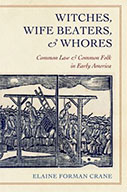Witches, Wife Beaters, And Whores: Common Law And
Common Folk In Early America

Author: Elaine Forman Crane
Publisher: Ithaca, NY: Cornell University Press, 2011. 278p.
Reviewer: Nigel J. Cohen | May 2013
The author’s purpose is to illuminate the role of law in colonial North America by using carefully-researched case studies, or microhistories, of multiple legal cases on a given topic in a place and time, although the latter may run to several decades. The subtitle is subtly misleading if it leads you to expect a book solely on English colonies on the Eastern seaboard of the future United States. Elaine Forman Crane, a well-established history professor, treads fresh ground in New Amsterdam and Bermuda before returning to the scholarly shoals of Rhode Island and Providence Plantations, then finishes with ghostly testimony on Maryland’s Eastern Shore.
Between the introduction and the epilogue, the six chapters deal with Dutch slander, Bermudan witchcraft, domestic violence, attempted rape in criminal and civil law, a murder case which turns out to be about debtors and creditors, and a decedent’s apparition in Maryland’s case against an estate’s administratrix (in layman’s terms, the dead farmer’s ghost came back to help support his out-of-wedlock children). The last case was publicized several years after the fact, in what appears to be a Federalist attempt to discredit Jeffersonian lawyer-politicians. The chapter on attempted rape also delves into issues of slavery, property, and personhood, because the alleged perpetrator was a ferry-captain slave, while the accuser was a White widow.
One theme that runs through the book is the role of women in society, e.g., as merchants in New Amsterdam, and how a woman’s role may have influenced a man to sue her for slander or accuse her of witchcraft. Of course, as the author goes in depth to show, men were also sued for slander by women, just as men were accused of witchcraft and hanged. The author’s analyses are generally on point, and she does well to note when she is speculating as to motives or genealogy. I found myself shuttling back and forth between the chapters and the copious endnotes, wishing that the publisher had used law review style footnotes at the bottom of each page for such a scholarly book.
Despite the difficulty in finding bones to pick in an exhaustively researched and well-written book (the witty turns of phrase are lively without being contrived), there are minor quibbles a reader may have. The historical meaning of “common law” comes from England after the Norman Conquest of 1066. The kings, notably Henry II, set up royal courts with royal judges who rode circuit and issued decisions in the king’s name. This judge-made law replaced the customary law that varied from village to village, and thus became the law that was “common” to all of England, although there were still certain regional variations for hundreds of years, e.g., primogeniture versus the division of land by equal male inheritance. Common law is often contrasted with the “civil law” of Continental Europe that derived from Roman law, such as Justinian’s Code. Crane concludes a paragraph on skimmingtons or “rough music” (mob action) by writing that “rough music was part of a legal tradition: common law, after all, derived from customs that existed from time immemorial and were not only ancient, but frequently unwritten” [p. 114]. It is debatable whether one should equate mob action with “common law”; Crane omits that skimmingtons had a long tradition in regions of France, a civil law nation with strong community customs and festivals.
Later in the wife-beating chapter, Crane writes: “Timely intervention by authorities in the know might have averted the death of these [four] women, but an eighteenth-century worldview precluded their involvement until it was too late” [p. 116]. A look at U.S. Department of Justice statistics on domestic violence homicides since the 1990s, or the U.S. Supreme Court jurisprudence on violence against women (e.g., Congressional remedies violate the Commerce Clause), could lead one to question how much the 1700s worldview on the subject changed over the following 250 years!
The epilogue connects the stories of law from 1610-1810 to the westward expansion of the United States following the Louisiana Purchase. “Law continued to shape life by framing and impinging on familial, social, and business relationships. Building on two centuries of colonial experience, western settlers were well positioned to define the ‘other’—outcasts, deviants, and villains” [p. 211]. Crane sees legal history as a microcosm of “the American experience” [p. 215]. This book could be used by law or history professors, with each chapter (and accompanying notes) a self-contained unit. The general history reader who would like to learn rich details of colonial life will also find this book to provide insights into how people thought and acted in bygone times.
Nigel J. Cohen, Attorney at Law, Independent Scholar


